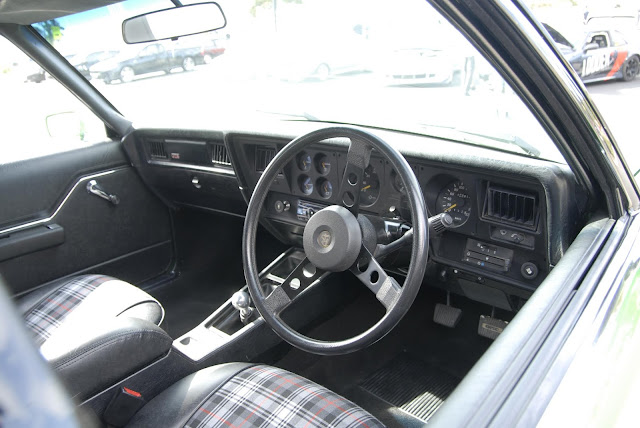(Mainly) Japanese January, 2019.
I've named today's post - my first ever from Cars & Coffee, Hobart - (Mainly) Japanese January because the organisers promoted it as such. As it was my first time at the Cambridge-based get-together (https://www.facebook.com/carsandcoffeehobart/), I can't say how many vehicles from the Land of The Rising Sun would normally be in attendance but, either way, there was a pretty good showing of Mitsubishis, Toyotas, Datsuns / Nissans, Mazdas and Subarus.
There was also a very large contingent of Aussie, American, British and even German machinery (no Italians, though). However, I mainly concentrated on the Japanese cars because I've got a bit of a thing for them - especially 1970s' hardtops and coupes - and because they're been hugely under-rated until fairly recently.
According to the owner of this immaculate 2.4 litre fuel injected, independent rear suspension-equipped Celica, he's only its third owner since new. He also told me that, apart from a tiny bit of touch-up here and there, it's completely original and has only a bee's penis more than 100,000 k on the clock. Nice!
This super straight, super original looking early model Celica was absolutely immaculate. As far as I could see, it was totally stock, save a set of very tasty 13" alloys.
I might normally have been tempted to do a whole post on this awesome-looking Skyline alone. However, it does already feature quite extensively in a previous article I wrote about the 2018 Club Motori Italia Lufra hill climb (just search Lufra in the search bar on the top right hand corner of the home page for details).
German, right? Sort of yes and sort of no. The radiator mounted in the front might give you a bit of a clue ... .
Four-wheel cross-drilled discs suggests maybe a bit quicker than your average Beetle ... . And what's all that plumbing surrounding its flat-four engine?
Yep. A Subaru motor, most likely from a WRX. This is one serious sleeper V-Dub!
Notice anything different about this Corolla? I did pick up that the front-end wasn't quite like those of the Australian domestic model twin cams of the era but wasn't sure about the two doors. As it turns out, it's a very rare beast in this country - one of maybe only half a dozen or so FX GT Limiteds imported direct from Japan - and its owner has another, albeit slightly less performance orientated version. The wheels are Aussie-made ROHs but there's credible evidence they may be off an original Bathurst 1000 Corolla racing car.
Not even a little bit Japanese, I will admit. However, I couldn't resist including this fabulous AMC Rambler Gremlin. As a contemporary of one of my all-time favourite US-made cars, the Rambler Hornet, it was just too interesting to omit. That and the fact that it was an original left-hand drive and was in really great nick!
You can see this and a number of equally excellent Datsun Fairladies by going to one of my UMPH Classics by the Beach posts. Even though I've seen, photographed and written about this car before, today was the first time I noticed the clever vertically-mounted radio in the centre console.
 |
| That's lateral - or should that be vertical - thinking? |
Clearly an HZ Holden GTS isn't Japanese, either. Nor is the HJ LE coupe that follows. What piqued my interest, however, was that whilst both cars are commonly thought of as Monaros, technically neither is. Don't believe me? Check them out. No Monaro badging anywhere, as both were marketed by GM as a separate model, making the HX the last of the official Monaro line until the Commodore-based models were released.
While I'm on my not-Japanese theme, I couldn't resist the juxtaposition of the latest hi-tech Mini shown above and its spiritual ancestor, the Sports 850, featured below. And if I were really feeling pedantic, I'd also point out that, as a BMW product, the newbie's really German whereas the classic's as British as a bowler hat.
Datsun 120Ys don't come much better than this! Sure, it's the tiniest bit faded here and there but it's straight, rust-free and has a great interior. The spoiler and Superlite-styled wheels really suit it, as do the era-correct roof bars. Even the number plates are original. Grandma would be proud!
All but one of the remaining cars also fall outside the Japanese theme but, hey, I could hardly ignore them! As usual, there were also lots of cars that I just couldn't fit into one post, many of which are featured elsewhere on uppermiddlepetrolhead, so please don't be offended if your pride and joy isn't shown here today.
Did you like this post? If so, please feel to have a look-see around the rest of the uppermiddlepetrolhead.blogspot.com.au site. There's a search facility in the top right corner of the page that allows you to find any of the hundreds of classic, sports and performance cars from Tasmania and mainland Australia, as well as many, many car shows and motor sports events. It's like a local on-line car mag but for free! Please share!!
U M P H
(uppermiddlepetrolhead.blogspot.com.au)






































































Comments
Post a Comment